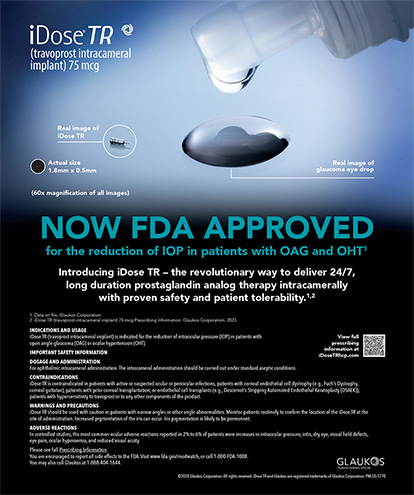From diagnosis to treatment, the field of glaucoma is brimming with exciting new developments. Here is an overview.
DIAGNOSTICS
An innovative visual field test for the earlier and more accurate detection of glaucomatous damage is on the horizon.1 The technology is based on flicker defined form (FDF) phase contrast thresholds. As opposed to a light stimulus, the target in the FDF field is a visual illusion that appears as a phantom contour. This sense of a border or contour may take any geographical shape and is generated by flickering rapidly between a background and randomly positioned stimulus dots.2 The goals of this technology are to reduce the usual background noise prevalent in standard visual field screenings and more accurately detect the decline in contrast sensitivity that plays such an important role in glaucomatous visual impairment.
The flickering concept is also being utilized for assessing the optic nerve in an attempt to detect glaucomatous damage earlier.3 The technology transposes serial photographs of the optic nerve from the same patient on top of each other. The program then rapidly shifts from one photograph to another in a flickering fashion. It thus allows the examiner to detect changes in the contour of blood vessels or rim over time in order to identify glaucomatous progression in the optic nerve more easily.
SURGERY
Amniotic membrane is widely used by cornea specialists to treat pterygia4 and other ocular surface diseases.5,6 The popularity of this unique tissue for glaucoma operations is beginning to grow. For example, surgeons can use amniotic membrane as an alternative to pericardium or sclera to form a patch graft over a tube shunt. Owing to its transparency, amniotic membrane is cosmetically preferable to standard patch grafts, especially in patients with prominent globes. Thinner than Tutoplast (IOP Inc., Costa Mesa, CA), amniotic membrane also allows for easier closure over the tube when the amount of available conjunctiva is limited. For this reason, glaucoma surgeons are also using amniotic membrane to cover exposed tube shunts around which the conjunctiva is scarred.7
By promoting conjunctival epithelialization, amniotic membrane can cover a tube shunt without the need for overlying conjunctiva.8 For that reason, amniotic membrane is ideal in the repair of intraoperative conjunctival buttonholes9 as well as postoperative bleb leaks.10 The results of initial case series have been promising and demonstrated watertight closure and the maintenance of a functioning bleb.
Like other patients, those with glaucoma are becoming more demanding about their visual outcomes after cataract surgery. Ophthalmologists are therefore beginning to explore the use of toric IOLs in combined cataract and filtering surgeries. One concern about using these lenses in combined procedures is that they might rotate if the depth of the anterior chamber changes dramatically. In the authors' experience, however, the IOLs have stayed firmly in position when the chamber has become shallow or has been reformed, and they even remained stable in an eye that subsequently developed malignant glaucoma. Toric lenses are of particular value to patients with glaucoma, because many of them have undergone trabeculectomy procedures, which induce varying degrees of refractive astigmatism.11 This refractive error can be visually disabling for patients who already have corneal astigmatism in a similar axis. Toric lenses allow surgeons to optimize these patients' uncorrected distance vision after cataract extraction.
CONCLUSION
Unfortunately, Alcon, Inc. (Huenenberg, Switzerland), announced on July 2, 2009, that it had discontinued its development of anecortave acetate for the reduction of IOP. Delivered as a single anterior juxtascleral injection, the drug had been shown in pilot clinical studies to provide a sustained IOP-lowering effect for up to a year.12,13 The company made its decision after reviewing the interim safety and efficacy data from a large, controlled, phase 2 trial. Although this research reportedly confirmed that a single injection measurably reduced IOP for an extended period of time, the company stated that the amount of the decrease and the responder rate were insufficient to support further development of this novel intervention.
New IOP-lowering drug delivery systems are highly desirable as a way of addressing problems with patients' adherence to prescribed glaucoma therapy. Despite this setback, the field of glaucoma continues to advance. The FDF visual field and flicker photography are two examples of new technologies. Additionally, amniotic membrane and toric IOLs—commonly used by other subspecialists—are now being employed in fresh and exciting ways to treat patients with glaucoma.
Parul Khator, MD, is a glaucoma fellow at Wills Eye Hospital in Philadelphia. She acknowledged no financial interest in the products or companies mentioned herein. Dr. Khator may be reached at khator6@hotmail.com.
Marlene R. Moster, MD, is a professor of ophthalmology at the Thomas Jefferson Medical College and is an attending surgeon at Wills Eye Hospital in Philadelphia. She acknowledged no financial interest in the products or companies mentioned herein. Dr. Moster may be reached at (484) 434-2717; moster@willsglaucoma.org.


